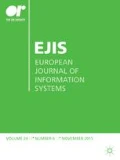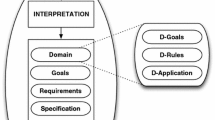Abstract
The assumption that tacit knowledge cannot be articulated remains dominant in knowledge elicitation. This paper, however, claims that linguistic theory does not support such a position and that language should not be factored out of accounts of tacit knowledge. We argue that Polanyi's (1966, p. 4) widely cited notion that ‘we know more than we can tell’ uses a folk model of language. This model does not acknowledge the linguistic patterns that competent language speakers deploy without direct awareness. This paper draws upon Systemic Functional Linguistics (SFL) to propose a Grammar-targeted Interview Method (GIM). The GIM uses SFL to unpack linguistic patterning, which we refer to as ‘under-representation’, to reveal tacit assumptions. It is a strategy that can be applied within a traditional interview method when the interviewer feels that there is confusion resulting from assumptions, such as those often embedded in terminology, that have not been directly expressed. This paper reports findings from an empirical study of tacit knowledge about requirements analysis in a Content Management System redevelopment. We compared the GIM with a Content-motivated Interview Method (CMIM) and show that, when the GIM is used, interviewees respond with less nominalised talk, that is the less nominalised content has more meaning unpacked as verbs and agents rather than hidden tacitly in nouns.




Similar content being viewed by others
References
Agarwal R and Tanniru MR (1990) Knowledge acquisition using structured interviewing: an empirical investigation. Journal of Management Information Systems 7 (1), 123–141.
Ågerfalk PJ, Goldkuhl G, Fitzgerald B and Bannon L (2006) Reflecting on action in language, organisations and information systems. European Journal of Information Systems 15 (1), 4–8.
Ambrosini V (2001) Tacit knowledge: some suggestions for operationalization. Journal of Management Studies 38 (6), 811–829.
Baumard P (1999) Tacit Knowledge in Organizations. Sage, London.
Boisot M (1995) Information Space. A Framework of Learning in Organizations, Institutions and Culture. Routledge, London.
Busch P (2004) Acquisition of articulable tacit knowledge. In Proceedings of the Pacific Knowledge Acquisition Workshop (KANG BH, HOFFMANN A, YAMAGUCHI T and YEAP WK, Eds), p 87, Springer, Auckland, New Zealand.
Castillo J (2002) A note on the concept of tacit knowledge. Journal of Management Inquiry 11 (1), 46–57.
Clark RJ (2001) Studies in organisational semiotics: an introduction. European Journal of Information Systems 8 (2), 75–82.
Collins HM (2001) Tacit knowledge, trust and the Q of sapphire. Social Studies of Science 31 (1), 71–85.
Ericsson KA and Simon HA (1993) Protocol Analysis: Verbal Reports as Data. MIT Press, Cambridge, MA.
Firth JR (1957) Papers in Linguistics 1934–1951. Oxford University Press, London.
Halliday MAK (1989) Spoken and Written Language. Oxford University Press, London.
Halliday MAK (1994) An Introduction to Functional Grammar 2nd edn, Arnold, London.
Halliday MAK and Martin JR (1993) Writing Science: Literacy and Discursive Power. Critical Perspectives on Literacy and Education. Falmer Press, London.
Halliday MAK and Matthiessen CMIM (1999) Construing Experience Through Meaning: A Language-Based Approach to Cognition. Cassell, London.
Halliday MAK and Webster J (2002) On Grammar. The Collected Works of M.A.K. Halliday. Continuum, London.
Hirschheim R, Klein HK and Lyytinen K (1996) Exploring the intellectual structures of information systems development: a social action theoretic analysis. Accounting, Management and Information Technologies 6 (1–2), 1–64.
Iedema R (1997) The language of administration: organizing human activity in formal institutions. In Genre and Institutions: Social Processes in the Workplace and School (MARTIN JR and CHRISTIE F, Eds), pp 73–100, Cassell, London; Washington.
Jakobson R (1971) Selected Writings 2d, expanded edn, Mouton, The Hauge.
Linde C (2001) Narrative and social tacit knowledge. Journal of Knowledge Management 5 (2), 160–170.
Martin JR and Veel R (1998) Reading Science: Critical and Functional Perspectives on Discourses of Science. Routledge, London; New York.
Matthiessen CMIM (1995) Lexicogrammatical Cartography: English Systems. International Language Sciences, Tokyo.
McKenna B and Graham P (2000) Technocratic discourse: a primer. Journal of Technical Writing and Communication 30 (3), 219–247.
Nonaka I and Takeuchi H (1995) The Knowledge-Creating Company: How Japanese Companies Create the Dynamics of Innovation. Oxford University Press, New York.
O’Donnell M (2002) Systemic coder. Wagsoft Systems.
Polanyi M (1958) Personal Knowledge: Towards a Post-Critical Philosophy. The University of Chicago Press, Chicago, IL.
Polanyi M (1966) The Tacit Dimension. Peter Smith, Glovcester, MA.
Polanyi M (1969) Knowing and being. In Knowing and Being: Essays (GRENE MG, Ed), The University of Chicago Press, Chicago, IL.
Reber AS (1993) Implicit Learning and Tacit Knowledge: An Essay on the Cognitive Unconscious. Oxford University Press, Oxford.
Richards D and Busch P (2003) Acquiring and applying contextualised tacit knowledge. Journal of Information and Knowledge Management 2 (2), 179–190.
Rose D (1998) Science discourse and industrial hierarchy. In Reading Science: Critical and Functional Perspectives on Discourses of Science (MARTIN JR and VEEL R, Eds), pp 236–265, Routledge, London.
Stamper R (1997) Organisational semiotics. In Information Systems: An Emerging Discipline? (MINGERS J and STOWELL F, Eds), pp 267–283, The McGraw-Hill Companies, London.
Sternberg RJ (1985) Beyond IQ: A Triarchic Theory of Human Intelligence. Cambridge University Press, Cambridge; New York.
Sternberg RJ (2000) Practical Intelligence in Everyday Life. Cambridge University Press, Cambridge, New York.
Suchman LA (1987) Plans and Situated Actions: The Problem of Human-Machine Communication. Cambridge University Press, Cambridge.
Tsoukas H (2002) Do we really understand tacit knowledge? Paper presented at the Knowledge Economy and Society Seminar. London School of Economics Department of Information Systems, London.
Tsoukas H and Mylonopoulos N (2004) Organizations as Knowledge Systems: Knowledge, Learning, and Dynamic Capabilities. Palgrave Macmillan, New York.
Wenger E (1998) Communities of Practice: Learning, Meaning, and Identity. Learning in Doing. Cambridge University Press, Cambridge; New York.
Winograd T and Flores F (1986) Understanding Computers and Cognition: A New Foundation for Design. Ablex, Norwood, MA.
Zappavigna M (2007) Eliciting tacit knowledge with a Grammar-targeted Interview Method. Unpublished Dissertation, School of Information Technologies, University of Sydney, Sydney.
Author information
Authors and Affiliations
Corresponding author
Rights and permissions
About this article
Cite this article
Zappavigna, M., Patrick, J. Eliciting tacit knowledge about requirement analysis with a Grammar-targeted Interview Method (GIM). Eur J Inf Syst 19, 49–59 (2010). https://doi.org/10.1057/ejis.2010.1
Received:
Revised:
Accepted:
Published:
Issue Date:
DOI: https://doi.org/10.1057/ejis.2010.1



